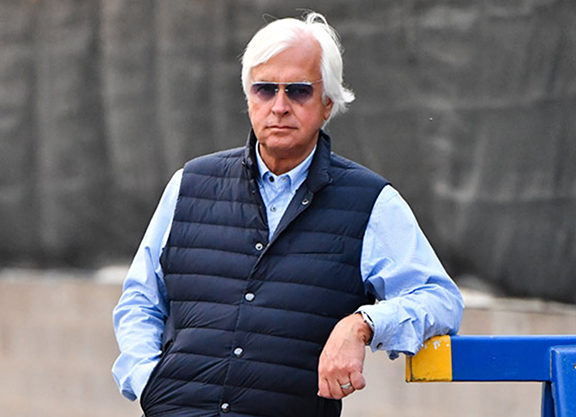Bob Baffert's attorney issued a statement Tuesday saying that New York Times reporter Joe Drape's reporting in 2019 on Justify's scopolamine positive was a “false story and narrative” which “were definitively debunked” in last week's California Horse Racing Board hearing on the matter.
The statement from attorney W. Craig Robertson III reads, in full:
“On September 11, 2019, Joe Drape of the New York Times published an article concerning trainer Bob Baffert and Triple Crown-winning horse Justify. The article strongly and inaccurately suggested that Mr. Baffert had intentionally doped Justify with scopolamine in the 2018 Santa Anita Derby, and falsely stated that scopolamine was a performance-enhancing substance. Mr. Drape similarly implied that the California Horse Racing Board, which had investigated the facts surrounding Justify and determined that there had been no wrongdoing, was corrupt and covering up for Mr. Baffert's alleged misconduct.
“Last week, Mr. Drape's false story and narrative were definitively debunked. In a public hearing on the Justify case, the California Horse Racing Board, which now consists of members that are entirely different from the allegedly `corrupt' ones in place in 2018, stipulated that the presence of scopolamine in Justify: (1) was the result of environmental contamination, specifically that Justify was inadvertently exposed to hay containing a naturally growing plant called jimsonweed, which contains scopolamine; and (2) there was no performance-enhancing effect on Justify in the Santa Anita Derby. Thus, it has now been conclusively and legally established that the entire premise of the (2019) New York Times story on Justify was false.
“Mr. Drape's coverage of Mr. Baffert continues to be inaccurate in other significant respects. For example, recently he has repeatedly accused Mr. Baffert of medication violations in Arkansas and Kentucky involving “banned” substances when, in fact, each of those cases involve lawful, therapeutic medications. These representations are similarly false and must be corrected.”
On October 22, Drape wrote that Gamine had tested positive for a “banned substance” in the Times. Robertson responded at the time, “Betamethasone is a legal, commonly used anti-inflammatory medication. It is not a `banned substance.' ”
Robertson's Tuesday email to the media said that Baffert would be issuing his own statement Wednesday.
In August, the CHRB announced that the win by Justify in the 2018 running of the GI Santa Anita Derby would come under official administrative scrutiny by the organization, but that Baffert, the trainer of the eventual undefeated Triple Crown winner, would not have a CHRB complaint lodged against him “due to substantial evidence that the scopolamine resulted from environmental contamination from jimson weed.”
The CHRB has yet to issue a ruling following last week's scopolamine hearing.
A now-controversial 2018 commission vote to exonerate Justify and Baffert was not publicly disclosed, and took place privately after a detailed investigation that substantiated the environmental contamination by jimsonweed. In roughly the same timeframe in 2018, the CHRB received positive post-race tests for scopolamine on five other horses from other barns, and the CHRB eventually treated them all as unintentional jimsonweed contaminations from ingesting tainted hay.
“This case was correctly decided by the CHRB in 2018. It was a final and binding decision. And nothing has changed since then, and you all should simply affirm that decision so that we can put this matter to bed once and for all,” said Robertson at last week's hearing. “When that investigation was complete, there were two things that were clear, undisputed and undeniable. Number one, that this was a case of innocent environmental contamination from hay and it was not a case of any intentional administration of any drug or medication. And number two, that the trace levels of scopolamine…had no effect on the performance of these horses and no effect on the races.”
Drape revealed the scopolamine positive in a New York Times article September 11, 2019 in which he wrote, “Justify should not have run in the Derby, if the sport's rules were followed” and suggested that the investigation had not been detailed at all.
“It decided, with little evidence,” he wrote, “that the positive test could have been a result of Justify's eating contaminated food. The board voted unanimously to dismiss the case. In October, it changed the penalty for a scopolamine violation to the lesser penalty of a fine and possible suspension.”
Testimony at last Thursday's hearing indicated that change in classification of scopolamine was already in the works long before Justify's positive.
In the story on the hearing, the TDN's T.D. Thornton wrote, “The CHRB, by its own regulation, follows the Association of Racing Commissioners International (ARCI) Uniform Classification Guidelines for Foreign Substances and Recommended Penalties when establishing model rules for drugs. The ARCI once classified scopolamine as a Class 3 drug (lower-number classifications are more severe). But in December 2016, the ARCI reclassified it to a lesser Class 4 offense.
“Arthur testified that the CHRB fully intended to follow the ARCI's model rule that reclassified scopolamine (and other drugs that also changed classes). But since California's Office of Administrative Law doesn't allow the CHRB to change rules by automatically referencing another authority's code, the racing agency has to go through a drawn-out process to make even minute changes such as drug reclassifications. So because of this bureaucratic backlog, scopolamine in 2018 was still technically Class 3 in California, even though Arthur and the CHRB considered it to match the ARCI's newer Class 4 downgrade.
“Arthur explained how as the equine medical director, he has regulatory leeway to take into consideration mitigating circumstances, and that's what he did when recommending no initial penalties for the scopolamine positives.”
“It is inherently unfair to hold somebody to a classification that is outdated because of regulatory inefficiency,” Arthur said at the hearing.
Not a subscriber? Click here to sign up for the daily PDF or alerts.






